Zero to 400, Part 4: Tackling the A2 CofC

Zero to 400 is a record of my journey from casual observer to (hopefully) confident drone pilot. This isn’t a detailed guide to legislation, and I’m certainly no expert on the ever-changing world of drones. I hope these posts can serve as a guide to the novice pilot and answer the basic questions from anyone interested in drones.
After getting to grips with the Drone Code, receiving a Flyer ID, and learning about drone qualifications, I finally did a bit of flying.
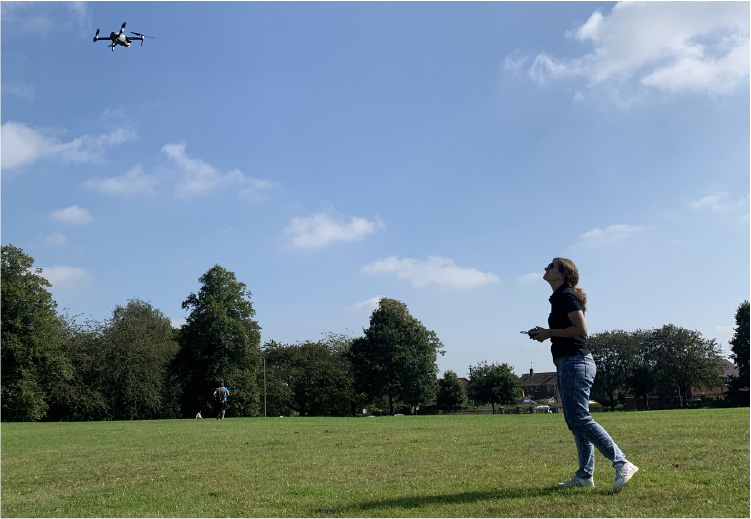
With the Flyer ID, I can only fly within the A1 and A3 subcategories. We talked about that in the last post – if you missed it, you can read it here.
I’d quite like to fly in the A2 subcategory also. A2 gives me a bit more flexibility: I can fly a larger drone, closer to people and in urban areas. Because we use the DJI Mavic 2 for work flights, in all sorts of locations, I decided to look into it.
The A2 CofC
To fly in the A2 subcategory, I need to get an extra qualification. This is called the A2 Certificate of Competence (or, A2 CofC for short).
There are lots of different course providers for the A2 CofC, but the format is usually the same. There is a short training course, followed by an exam. Most of the courses are online – I’m not sure if this is a Covid thing.
Before completing the exam, you need to have received a Flyer ID and have carried out some practical flying.
Enrolling in a Course
For my A2 CofC, I used Consortiq, who run the training in partnership with Leaping Wing. The course is delivered via a 3-hour online training course, followed by the exam.
Before the course, I was sent joining information and a link to the Leaping Wing online learning portal.
I was asked to work through some of the learning content ahead of the course. This was posted to me in a handy training book.
Being the terrible student that I am, I forgot about the course and waited until the night before to pick up the book.
On the day of the course, we were invited to join via Google Meet. I was surprised to find it was only a small group – two of us were taking the exam, two were course trainers.

Course Content
Three hours can fly by quickly when it’s well-planned. I was pleased with how interactive the course was – it felt like more of a conversation than a lecture. The trainers talked us through each module, discussed the regulation changes and asked us to relate to our own practical experiences. There were lots of questions and discussions throughout.
The modules covered areas such as meteorology, battery types and flight planning. Some of the information was similar to the Flyer ID. Some of it was more technical, like battery load capacities and weather fronts. There were a few topics I wasn’t well-versed in, but nothing too complicated.
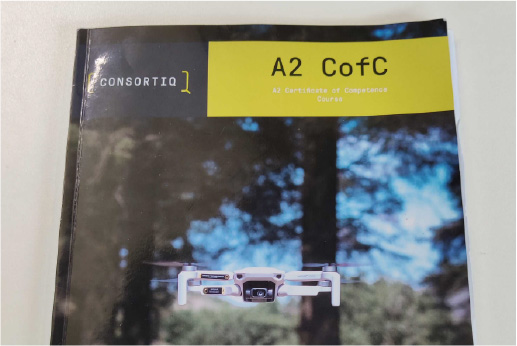
Doing the Exam
At the end of the 3-hour course, we reviewed what we had learned and were given a quick break before the exam. Like the Flyer ID, it’s a multiple-choice test done online. As we were working from home, we were asked to keep mics and cameras on during the test. I guess that’s to check we weren’t trying to cheat!
Although we had over an hour to complete the exam, I think both of us were finished within 30 minutes.
The course prepared us for the exam well and I found just two or three questions where I was second-guessing myself. In the end, I passed with just one question incorrect.
After the exam, I was sent the A2 CofC certificate by email. It looks a bit like the Flyer ID, with a CAA logo and QR code on it.
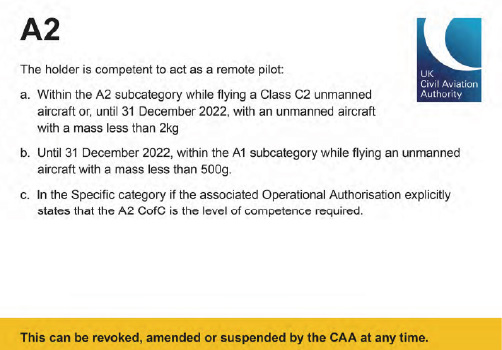
Final Thoughts
The A2 CofC is a course I believe is worth doing. The content was informative, the format was straightforward and the exam wasn’t too challenging. I’d definitely recommend it to other pilots, especially those like me who don’t have a strong aviation background.
After the course, I spoke to Michael Surcombe, Director of Leaping Wing, who delivered the training.
“The A2 Certificate of Competency is a great option for anyone looking to fly drones, especially if they are starting out with a new business. Before we had the A2, the barriers to entry were needlessly high for people intending to fly lighter drones.
Should drone flyers take the A2 at all? Definitely, at least if they are going to be flying anything bigger than pocket drones. WIthout an A2 qualification, you’re really limited as to where you can fly legally (think ‘big open field’). There’s also a real danger you’re inadvertently going to fly somewhere which is going to get you into trouble. Interestingly, I’ve had people come to me for the A2 certificate who probably didn’t need to from a legal perspective. However, they want to be sure they are flying safely and legally. The A2 CofC is the perfect way to achieve that.
One thing I’m REALLY passionate about is that we make the course as relevant to people’s flying as we can. We follow a core CAA curriculum, with our course partners Consortiq. That means we cover weather, technical knowledge and operating limitations/procedures. But I also cover as much as I can on how to get the best results from your drone. Areas such as camera setup and efficient planning. Quite a few people also ask for a flight training session, just so they don’t have to spend hours on YouTube working things out!
In short, I think the A2 course is revolutionising the drone world. It’s making it easier than ever before for people to equip themselves with the skills to fly safely and build a business!”
– Michael Surcombe, Leaping Wing
You can find out more about drone regulations by clicking here.
We used Consortiq and Leaping Wing for the course. Check out the link below for more information:
Landowner Permission
Even with a good understanding of the regulations, it’s important to check for bylaws or local restrictions when you fly your drone. Check out The DronePrep Map for everything you need to plan flights safely.
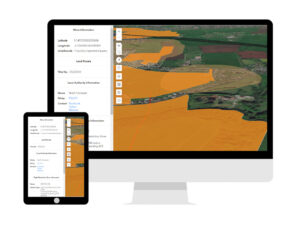
Marketing Manager at DronePrep and recent returnee to the UK after a long stint abroad. Rookie drone pilot, avid writer and lover of all things tech.

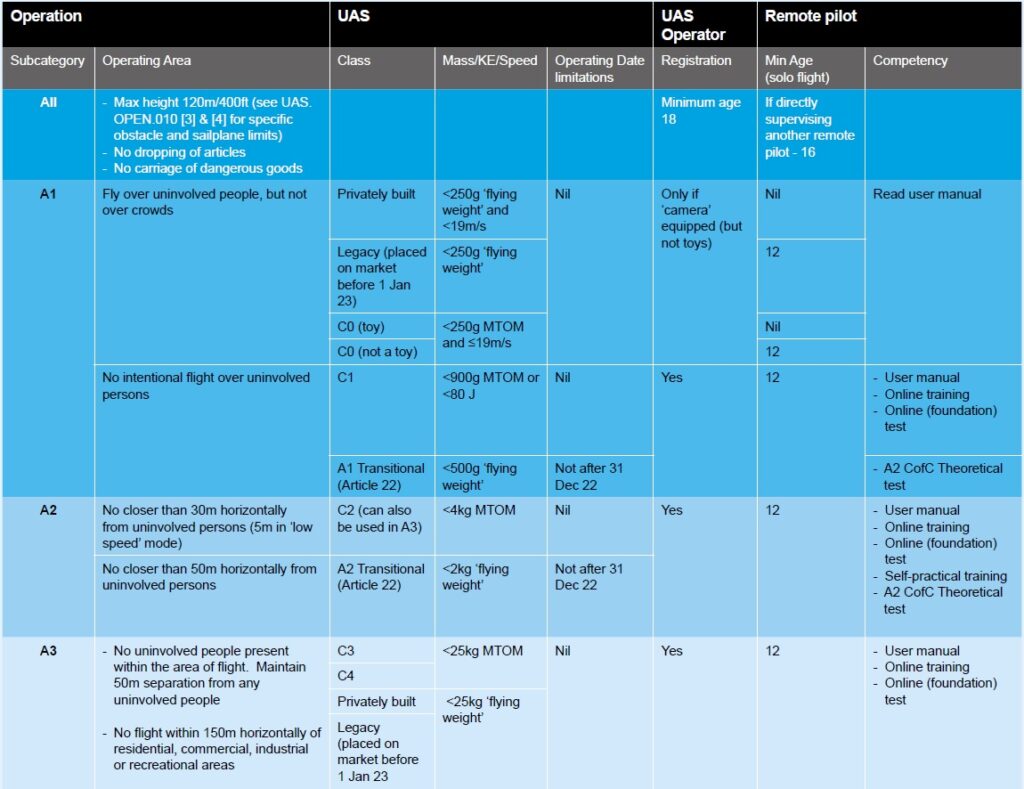
 Preparing for the Test
Preparing for the Test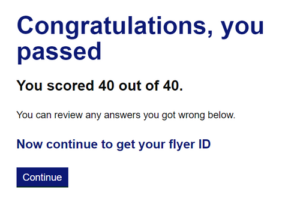 Some of the questions encourage you to consider the reasons behind an answer (No, because… Yes, because…) and you’ll need to get that part correct too. Imagine I ask you something like: “Should I fly my drone within 20m of a school playground?” and you are offered the answers: “No, because the kids might steal your drone” vs. “No, because flying within 150m of a built-up area is not permitted” – you get the idea.
Some of the questions encourage you to consider the reasons behind an answer (No, because… Yes, because…) and you’ll need to get that part correct too. Imagine I ask you something like: “Should I fly my drone within 20m of a school playground?” and you are offered the answers: “No, because the kids might steal your drone” vs. “No, because flying within 150m of a built-up area is not permitted” – you get the idea.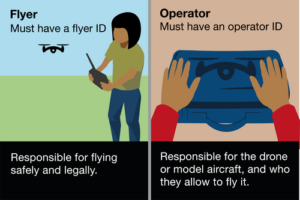 Operator ID
Operator ID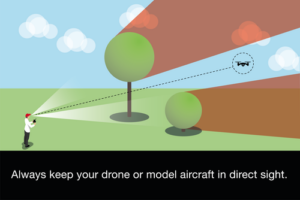 Much of the guide feels like common sense, but there are a few rules I wasn’t aware of. For example, you’re given extra leeway on the height limit when flying over a structure, but only if you’ve been asked to carry out some kind of task related to it – like photographing a wind turbine, for example.
Much of the guide feels like common sense, but there are a few rules I wasn’t aware of. For example, you’re given extra leeway on the height limit when flying over a structure, but only if you’ve been asked to carry out some kind of task related to it – like photographing a wind turbine, for example.